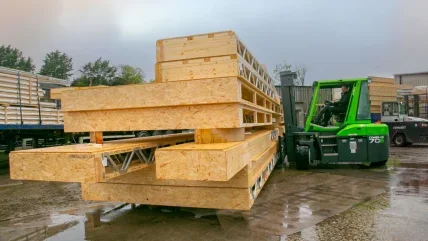
The timber sector’s long and distinguished history reflects the importance of this material in so many aspects of everyday life over the centuries. Many companies in the industry are as old as – or even older than – the TTJ itself.
James Latham, for example, first imported timber into the UK in 1757 and is still one of the UK’s largest independent distributors of timber, panels and decorative surfaces. Lawson and Son Timber Merchant is another long established company that celebrated its centenary in 2021.
Irrespective of age, what all timber suppliers have in common is the need to efficiently move volumes of product around, and most of these will use some sort of forklift truck. Before the invention of this very useful machine, manpower was the key to getting products from A to B. Horses, carts and the occasional motorised vehicles would also have been used to load up and carry out deliveries, but with less focus on health and safety, this was very often laborious, backbreaking and dangerous work.
Having proved their worth during the Second World War in moving vast volumes of materials in a short time frame and when manpower was needed elsewhere, the forklift market took off. What were originally rudimentary workhorses became more sophisticated over the decades, as manufacturers added features to offer better protection for drivers as safety played an increasingly important role.
Combilift also played its part in advancing materials handling operations when it launched its ground-breaking C4000 multidirectional forklift, a world first, in 1998.
Readers of TTJ will be familiar with the company and its rapid growth over the past 25 years as the now extensive and varied range of Combilift products is a firm favourite in the timber sector. The C4000 was quickly seen as a one-machine replacement for counterbalance/reach/sideloader combinations and enabled safe, space saving and productive handling and storage of long and bulky loads in confined spaces.
Lathams and Lawsons were early adopters of the Combilift concept; John Lawson recognised its potential at a trade fair in 1999 and Lathams acquired its first three C4000 trucks in 2001 for its Hemel Hempstead site. Both companies still operate extensive fleets at their various depots, but what has recently changed for them – and many others – is the gradual switch to electric powered Combilifts, which is in line with a general move to greener, emission-free operations.
As for the future – smart technology such as sensors and lasers have enabled the development of, for example, automated guided vehicles or robots (AGVs and AMRs).
But as we have seen with driverless cars, the timeline for successful introduction of these has been continually pushed back and it could be 2035 before a fully self-driving car is developed. So best to hold on to forklift operators for the time being, especially as their in-cab comfort and ergonomics have never been so good.





